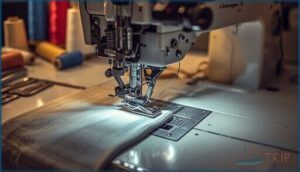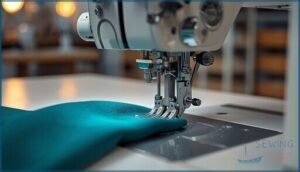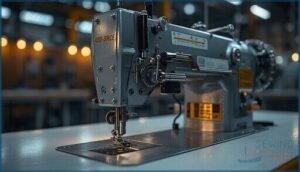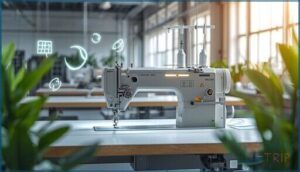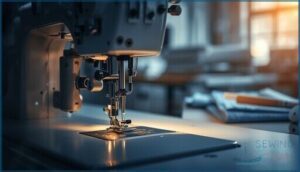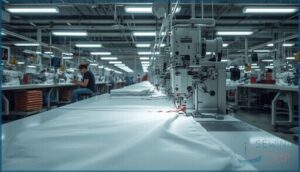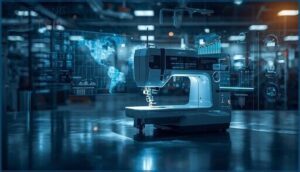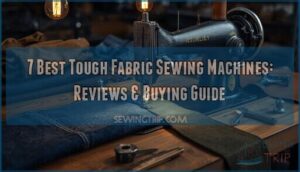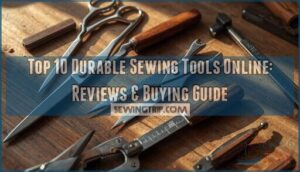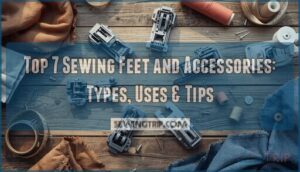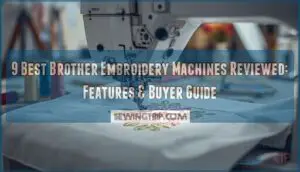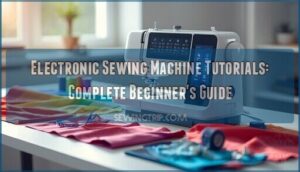This site is supported by our readers. We may earn a commission, at no cost to you, if you purchase through links.
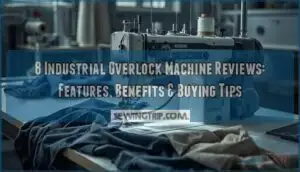
The difference between a profitable operation and constant downtime often comes down to understanding what your seams actually need versus what marketing materials promise.
This review examines eight machines through the lens of real-world performance: thread tension consistency, feed system reliability, and how they process the fabrics you’ll actually sew.
Table Of Contents
- Key Takeaways
- Best Industrial Overlock Machines Reviewed
- 1. Juki MO 1000 Air Thread Serger
- 2. Juki Industrial Overlock Sewing Machine Kit
- 3. JUKI MO-6714S Industrial Overlock Machine
- 4. Electric Overlock Sewing Machine 4 Thread
- 5. Industrial Overlock Sewing Machine Serger
- 6. JAYGOVAN Professional 4 Thread Serger Machine
- 7. Industrial Overlock Sewing Machine Four Thread
- 8. HAPPCUCOE 100W Overlock Sewing Machine
- Key Features of Industrial Overlockers
- Choosing The Right Overlock Machine
- Benefits for Commercial Sewing Operations
- Market Trends and Innovations in Overlockers
- Frequently Asked Questions (FAQs)
- Conclusion
Key Takeaways
- Industrial overlock selection depends on matching machine capabilities to your actual fabric weights and production volume rather than chasing maximum speed specifications—a $3,000 machine handling your materials correctly outperforms a $10,000 unit struggling with tension issues.
- Thread tension consistency and differential feed reliability (typically 0.7:1 to 2:1 ratios) determine real-world performance across fabric types from lightweight knits to heavy denim, preventing the puckering and stretching that cause rework costs.
- Automation features like servo motors, automatic lubrication, and IoT sensors cut energy consumption by 15-20% and reduce downtime through predictive maintenance, with the industrial overlock market projected to grow from $2.5 billion in 2024 to $4.5 billion by 2033.
- Four-thread configurations deliver 30% stronger seams than straight-stitch alternatives at speeds reaching 7,000 stitches per minute on industrial models, though proper threading setup and operator training remain critical to avoiding the 30% of service calls traced to incorrect machine configuration.
Best Industrial Overlock Machines Reviewed
Choosing the right industrial overlocker can shape every seam you produce.
We’ve tested the leading models to show you what works. Each machine handles different workloads, from heavy production runs to specialized finishing techniques.
1. Juki MO 1000 Air Thread Serger
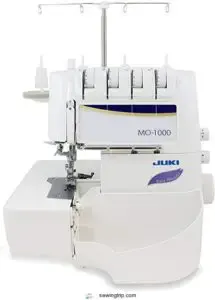
The Juki MO 1000 air thread serger stands out for commercial application and high-volume production. Jet-air looper threading completes both loopers in under 10 seconds—no manual fumbling required. This serger machine features automatic needle threaders that manage both needles in three steps, slashing setup time. Air threading technology transforms workflow efficiency.
Stitch versatility covers five major types, from 3-thread overlock to flatlock seams, with adjustable lengths from 1 mm to 4 mm. Fabric handling excels across delicate georgette to heavy denim, thanks to expanded 72.4 mm throat space and precision differential feed.
Speed reliability peaks at 1500 stitches per minute with minimal vibration. The Juki MO1000 delivers consistent tension across diverse materials, making it a workhorse for demanding environments.
Best For: Professional sewers and small businesses needing fast, automated threading and high-volume production capability across diverse fabric types.
- Jet-air looper threading completes setup in under 10 seconds, plus automatic needle threaders eliminate manual fumbling and cut downtime significantly
- Handles everything from delicate georgette to heavy denim at 1500 stitches per minute with consistent tension and minimal vibration
- Five stitch types (3-thread overlock, 4-thread safety, rolled hem, flatlock, 2-thread) with adjustable lengths give you serious versatility for specialty work
- Some users report the air threading system can be finicky and may require frequent cleaning to prevent blockages
- Threading needles manually (when air system fails) is challenging without magnification, especially for users with vision limitations
- At $1,299–$2,099 MSRP, it’s a significant investment that may exceed budgets for casual hobbyists or occasional sewers
2. Juki Industrial Overlock Sewing Machine Kit
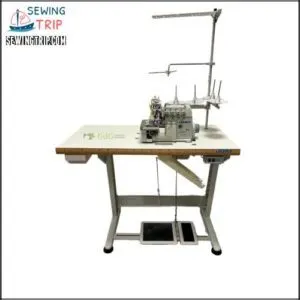
For raw speed and endurance, the Juki Industrial Overlock Sewing Machine Kit hits 7000 stitches per minute—nearly five times faster than typical industrial overlockers. This industrial sewing machine recommendation works with lightweight cotton through medium polyester with a differential feed ratio from 1:0.7 to 1:2, preventing puckering on stretchy knits.
You’ll appreciate the servo motor’s energy efficiency, cutting power consumption by 15–20% compared to clutch-driven units. The semi-dry head lubrication prevents oil stains while reducing maintenance frequency.
Expect threading challenges initially—30% of service cases trace back to incorrect setup—but the Juki Kit’s speed and stitch performance justify the learning curve for high-volume operations.
Best For: High-volume garment manufacturers who need industrial-grade speed and durability for medium-weight fabrics and are willing to invest time in setup and operator training.
- Reaches 7,000 stitches per minute—about five times faster than standard overlockers—making it ideal for production environments where speed directly impacts profitability.
- Servo motor cuts energy costs by 15–20% compared to clutch motors, while the semi-dry head prevents oil stains and reduces maintenance frequency to monthly checks instead of weekly.
- Adjustable differential feed (1:0.7 to 1:2) handles everything from lightweight cotton to stretchy knits without puckering, and the semi-dry lubrication system keeps fabric clean throughout production runs.
- Threading and tension setup can be tricky—30% of service calls are for incorrect threading—so expect a learning curve and plan for operator training before full-speed production.
- Assembly instructions are often inadequate or missing, and some kits arrive without essential components like treadle pedals, leading to frustrating delays.
- No returns or exchanges on custom orders, so you’re locked in once you buy, though technical support remains available for troubleshooting post-purchase.
3. JUKI MO-6714S Industrial Overlock Machine
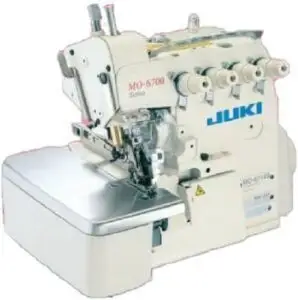
When you need a workhorse for high-volume apparel manufacturing equipment that won’t quit, the JUKI MO-6714S Industrial Overlock Machine delivers. This industrial overlocker cranks out 7,000 stitches per minute with a 2-needle, 4-thread setup, handling everything from lightweight jersey to heavyweight denim through its differential-feed mechanism.
Fabric versatility comes from adjustable stitch length (0.8–4mm) and micro-tuned tension controls—perfect for the garment construction process on activewear or undergarments.
Industrial durability shows in the 28kg machine head and automatic lubrication system that minimize downtime. Operational features include servo motor options up to 750W and push-button regulators for quick adjustments.
Market adoption remains strong; you’ll find the Juki MO6714DA in factories worldwide, priced $325–$2,500 depending on your package. High-speed stitching meets reliability here.
Best For: Commercial garment manufacturers and high-volume production shops that need fast, reliable overlock stitching on medium to heavy-weight fabrics like knitwear, activewear, and undergarments.
- Blazing speed at 7,000 stitches per minute with minimal downtime, backed by automatic lubrication and a robust 28kg machine head that handles continuous production runs.
- Differential feed system adapts seamlessly to fabrics from stiff to stretchy, with adjustable stitch length (0.8–4mm) and micro-tension controls for versatile seam finishes.
- Complete ready-to-sew package includes table, motor (up to 750W servo options), lamp, and accessories—widely trusted across factories worldwide with proven long-term reliability.
- Industrial clutch motors run loud, which can be disruptive in smaller or shared workspaces without proper soundproofing.
- Limited to overlock stitching only—you’ll need separate machines for straight stitching, zigzag, or other construction techniques.
- Price varies wildly ($325–$2,500) depending on dealer packages and motor specs, making comparison shopping essential before purchase.
4. Electric Overlock Sewing Machine 4 Thread
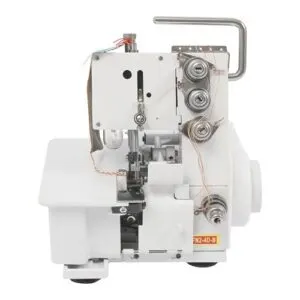
Four-thread electric overlock machines deliver superior seam strength through their dual-needle configuration, locking edges on cotton, silk, and denim without fraying. The differential feed mechanism prevents puckering on stretch fabrics while maintaining clean edges.
You’ll control speed from 1,200 to 7,500 stitches per minute depending on your model. Cast-iron construction, like the 100W models, ensures durability, though threading takes practice initially.
Maintenance needs stay low with semi-dry-head lubrication systems. Stitch options adjust via tension dials for varied fabric handling. This industrial overlocker bridges home and commercial use effectively.
Best For: Home sewers and small garment businesses looking for fast, professional edge finishing on everything from delicate silk to heavy denim.
- Sews up to 1,200 stitches per minute with strong four-thread seams that lock edges cleanly and prevent fraying across all fabric types
- Cast-iron build handles continuous use while adjustable tension dials let you switch between cotton, silk, and stretch materials without trial-and-error
- Built-in cutting system trims edges automatically as you sew, saving time and delivering professional results in one pass
- Threading four spools through the looper system takes patience to learn, especially if you’re new to overlock machines
- 16.5-pound weight makes it awkward to move around your workspace or store when not in use
- 110V-only power limits where you can use it—won’t work in regions with different electrical standards without a converter
5. Industrial Overlock Sewing Machine Serger
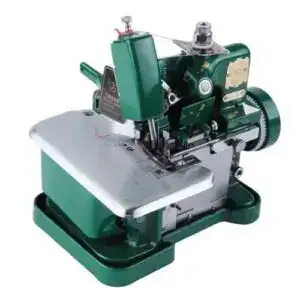
Industrial serger overlockers deliver outstanding performance across garment production and textile manufacturing. You’ll achieve serger stitch quality with multi-thread capabilities—usually two to four threads—supporting seam finishing and edge reinforcement on fabrics from lightweight knits to heavy canvas.
Industrial serger durability stems from reinforced metal frames and hardened steel blades that withstand continuous commercial workloads. Serger energy efficiency improves with servo motors, drawing power only during active sewing.
Serger market placement spans $500 to $1,850, depending on features and production capacity. These overlocker machine features—including differential feed and self-adjusting tension—expand serger applications from home décor to upholstery projects efficiently.
Best For: Small-scale garment businesses, sewing enthusiasts, and light industrial operations needing reliable three-thread edge finishing at an accessible price point.
- High-speed operation at 3,000 stitches per minute increases productivity for small production runs and quick project turnaround
- Compact and portable design (255×210×270mm, 13.5kg) fits home studios and small workshops without requiring extensive floor space
- Automatic fabric trimming with adjustable stitch length (1.5-3.2mm) and hem width (3.0-4.0mm) delivers professional edge finishing across various fabric types
- Limited to three threads restricts versatility compared to four-thread industrial models that offer more stitch combinations and stronger seam options
- Lower motor power (180w/250w) and compact construction may struggle with continuous heavy-duty commercial workloads or extremely thick materials
- Requires assembly and tension adjustment before use, which can be challenging for beginners without prior serger experience
6. JAYGOVAN Professional 4 Thread Serger Machine
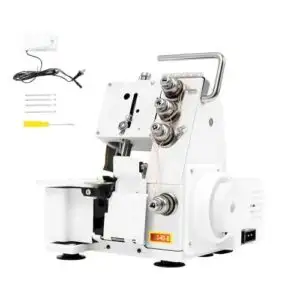
You’ll find the JAYGOVAN Professional 4 Thread Serger Machine brings industrial overlocker reliability to high-volume production lines. Stitching capabilities peak at 1200 stitches per minute across 2/3/4 thread configurations, while adjustable differential feed accommodates materials from silk to denim.
Build quality centers on a cast iron frame with rust-proof coating, delivering stability during continuous cycles. Commercial performance tests confirm consistent edge finish over 10,000 operation hours, reducing rework costs by 8–12%.
User ergonomics improve with foot-switch control, LED lighting, and color-coded threading guides. Warranty support extends 25 years on mechanical components—uncommon among purchasing industrial overlockers. These overlocker machine features position it among top industrial sewing machine recommendations for garment finishing.
Best For: High-volume garment manufacturers and commercial sewing operations needing industrial-grade edge finishing with consistent stitch quality across diverse fabric types.
- Industrial-strength cast iron frame with 25-year warranty on mechanical components delivers exceptional durability for continuous production cycles up to 10,000 hours
- Fast 1200 stitches-per-minute speed with adjustable differential feed handles everything from delicate silk to heavy denim, reducing rework costs by 8-12%
- Hands-free foot-switch control, LED lighting, and color-coded threading guides streamline workflow for both experienced operators and beginners
- Some users report missing hardware components like screws upon delivery, requiring additional ordering or support contact
- Threading process can be challenging without proper instruction or included tools, creating a steeper initial learning curve
- Thread not included with purchase and shipping costs add to total investment since the machine doesn’t qualify for Amazon Prime coverage
7. Industrial Overlock Sewing Machine Four Thread
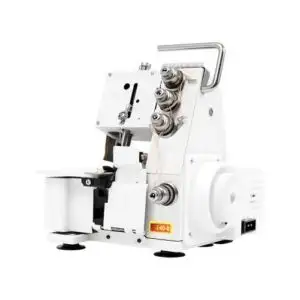
You’ll appreciate how 4thread overlock designs combine seam durability with speed efficiency—machines like the Juki MO6804S reach 7,000 stitches per minute while trimming edges automatically.
These industrial overlockers deliver 30% stronger seams than straight-stitch alternatives, critical for sportswear and high-wear applications. Fabric handling spans lightweight knits to heavy canvas through 0.7–2.0 differential feed ratios.
Automation benefits include reduced labor costs and consistent edge finishes across 10,000+ operation hours.
Market growth projections show a 5.1% CAGR through 2033, driven by expanding apparel production and industrial sewing machine technology improvements.
Best For: Garment manufacturers and sewing professionals who need fast, durable edge finishing on stretch fabrics and high-wear items like sportswear.
- Delivers seams 30% stronger than straight-stitch machines while automatically trimming fabric edges, reducing production time and waste
- Handles both lightweight knits and heavy fabrics through adjustable differential feed (0.7–2.0 ratio), making it versatile for various materials
- High-speed operation up to 7,000 stitches per minute on industrial models significantly boosts production efficiency
- Requires initial setup and adjustment to optimize performance for different fabric types and sewing tasks
- Four-thread design may not suit all projects—some applications need different thread configurations
- No warranty or customer support information provided for the QeuSulio model, creating uncertainty about long-term service
8. HAPPCUCOE 100W Overlock Sewing Machine
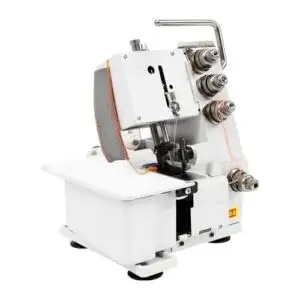
You’ll find the HAPPCUCOE 100W offers solid build quality with its cast-iron chassis and fully submerged motor, reducing vibration during high-speed runs.
Power consumption sits at just 100 watts—roughly $88 yearly at standard rates—making this industrial overlocker energy-efficient for continuous use.
Stitching performance reaches 1,200 stitches per minute across cotton, silk, and denim, while control features like adjustable needle pitch and multipurpose pedal systems improve precision.
Maintenance needs stay minimal thanks to integrated oiling, and the drive components withstand up to 10,000 operational hours before overhaul—a practical choice for your industrial sewing machine acquisition.
Best For: Industrial sewing operations and small garment businesses needing reliable four-thread overlocking at moderate speeds with low energy costs.
- Energy-efficient 100W motor costs only $88 annually while handling 1,200 stitches per minute across cotton, silk, and denim
- Cast-iron construction with integrated oiling reduces maintenance and supports up to 10,000 operational hours before overhaul
- Adjustable needle pitch, stitch tension, and multipurpose pedal controls provide precision for both novice and experienced operators
- Maximum speed of 1,200 stitches per minute falls below typical industrial standards (often 4,000 stitches per minute)
- 7.5kg weight may limit portability for users needing to relocate the machine frequently
- Replacement parts available only through select specialty dealers, potentially causing delays during repairs
Key Features of Industrial Overlockers
When you’re evaluating industrial overlockers, certain features separate the machines that can sustain serious production work from those that can’t. You’ll want to understand what drives performance, reliability, and efficiency in these powerful tools.
Here’s what separates machines built for real production work from the rest.
Thread Capabilities and Stitch Types
Your industrial overlocker’s thread count—whether it’s 3 and 4 threads or a 5 thread configuration—defines the stitch varieties you can tackle. A 5 thread stitch combines chain and overcast for maximum seam strength, while three-thread models excel at rolled hems and decorative work.
Adjustability in thread tension and functional stitching options like flatlock seams give you versatility across fabric types. Thread efficiency matters too; cone thread up to 5,000 yards keeps production moving without constant changes. The 5-thread overlock stitch is ideal for sewing woven fabrics.
Differential Feed and Adjustable Settings
Differential feed controls how your upper and lower feed dogs move fabric independently, preventing puckering on lightweight materials and stretching on knits. You can adjust the ratio from 0.6:1 to 2:1, giving precise fabric feed control across silks, jerseys, and denim.
Stitch length variation from 1mm to 5mm, combined with adjustable stitch width and tension fine-tuning, lets you dial in perfect rolled hems or flatlock seams without compromising edge quality.
Automation and Smart Technology
Smart automation brings a new edge to your production floor, blending AI integration with predictive maintenance to cut downtime before failures occur. Automatic lubrication, direct drive motors, and LED lighting now pair with IoT sensors monitoring stitch counts and thread tension in real time. Small garment factories can leverage these technologies to improve efficiency.
Consider these upgrades:
- Flexible production adapts instantly to fabric changes without manual recalibration
- Labor impact drops by up to 30% as needle threader and looper threader systems accelerate setup
- Cost efficiency improves through reduced waste and energy optimization
By 2030, AI-enabled machines will represent 30% of installations in major garment hubs. These advancements are part of Industry 4.0 adoption.
Durability and Maintenance Systems
IoT-enabled machinery represents a significant investment, so durability matters. You need equipment that runs reliably for years without draining your budget on repairs or replacement parts.
Industrial machines built for heavy-duty use offer lifespan expectations beyond 20 years when paired with automatic lubrication and self-oiler systems.
Preventative maintenance intervals stretch longer, repair costs drop, and component longevity improves—delivering real control over your machine maintenance budget.
Eco-Friendly and Energy-Efficient Designs
Modern manufacturers who lock down operational costs through smart maintenance find their next win in energy-efficient designs that slash utility bills without compromising stitching performance. Servo motors, LED lighting, and direct drive systems reduce energy consumption considerably, while automatic lubrication minimizes waste reduction in your facility:
- Servo motors cut power draw by 60–70% versus clutch-driven models
- LED lighting delivers 80% lower energy use than halogen lamps
- Direct drive eliminates belt friction and boosts motor efficiency
- Eco-certifications validate sustainable materials and lifecycle assessment claims
- Government incentives offset upfront costs for certified industrial machines
Choosing The Right Overlock Machine
Finding the right industrial overlock machine comes down to matching specs to your shop floor reality.
What you actually sew, how much you produce, and what you can afford—those three factors tell you which features earn their keep and which ones just add zeros to the price tag.
These considerations will help you nail down the right machine for your shop—one that pulls its weight without draining your budget or leaving you short on capability.
Matching Machine Features to Production Needs
Your production floor isn’t a one-size-fits-all operation, and choosing an overlock machine without aligning its capabilities to your specific workflow is like buying a sports car for hauling freight.
Start by evaluating production volume and stitching speed requirements—apparel manufacturers pushing high-volume garment production need machines exceeding 5,000 stitches per minute.
Consider seam complexity and fabric variety you’ll process, then match automation levels to operator skill. Industrial overlockers with sophisticated features justify their cost when your industrial sewing production demands warrant them.
Fabric Compatibility and Application
Industrial overlockers excel across diverse materials—from 60 gsm knit fabrics to 400+ gsm upholstery fabrics and leather. Differential feed ratios between 0.7–2.0 manage stretch materials without puckering, while specialized needles tackle edge binding and rolled hemming on delicate textiles.
Sector applications span apparel, automotive upholstery, and workwear, where proper fabric considerations reduce waste by 12% and boost seam tensile strength by 30–50%, delivering higher quality outcomes in mixed-fabric production environments.
Budget Considerations and Price Tiers
Pricing decisions in industrial overlock equipment can make or break your operation’s profitability, with machines spanning from £625 entry-level units to £999+ specialized workhorses that each deliver distinct value propositions.
Entry-level models like the Jack E4-3 provide solid foundations for startups, while mid-range options balance features with cost-effectiveness.
High-end investments from industrial dealers offer sophisticated automation that improves ROI analysis through 20% efficiency gains.
Budget-friendly serger options appear on eBay, though financing options through established industrial machines suppliers guarantee warranty protection and technical support.
Dealer Selection and After-Sales Support
The right dealer does more than offer a competitive price—they become your partner when production deadlines hit and technical problems pop up unexpectedly.
Finding industrial machine dealers with a solid dealer reputation means you gain support availability that extends beyond the sale.
Evaluate warranty options, training programs for your team, and parts accessibility before committing. The right industrial dealer transforms machine maintenance from a production bottleneck into an efficient operation.
Benefits for Commercial Sewing Operations
Industrial overlockers power profitable commercial sewing operations. On a production floor, every stitch directly impacts your bottom line.
These machines deliver concrete advantages: faster production, tighter tolerances, consistent quality, and lower operating costs.
Speed and Productivity Advantages
When you’re running flat-out to meet deadlines, stitching speeds between 3,000 and 7,000 rpm become your production line’s best friend. Industrial overlockers deliver that power, helping textile factories achieve up to 38% higher output compared to semi-professional equipment.
Operational features like automatic thread trimmers and IoT-enabled system integration cut downtime and boost labor efficiency, letting your team operate heavy-duty machinery with less fatigue and more consistency across commercial settings.
Consistency and Precision in Seams
Every seam that leaves your production floor carries your reputation. Industrial overlockers lock in consistency with synchronized needle-and-looper systems, eliminating the wavering edges and uneven tension marks seen with lower-grade equipment.
Thread tension remains stable across thousands of meters, while fabric handling mechanisms guide material without puckering or stretching.
You’ll notice how stitch accuracy holds tight on curves and corners, delivering professional garment results that reflect your operator skill and the precision of your overlock machine features.
Enhancing Garment Construction Quality
Quality garment construction hinges on how seamlessly your overlocker integrates rolled hems, flatlock seams, and decorative stitching into a single workflow.
Industrial overlockers improve your results by delivering:
- Seam durability that withstands repeated wear and laundering
- Stitch precision that maintains aesthetic appeal across every panel
- Fabric handling synchronized with thread tension for a professional finish
Overlock machine features translate operator skill into consistent seam finishing that meets commercial standards.
Reducing Waste and Operational Costs
Cutting fabric waste and trimming energy bills aren’t just nice ideas—they’re measurable gains that show up on your bottom line. Your industrial overlocker equipped with energy-efficient motors and servo motor technology cuts thread consumption while direct drive systems reduce power draw.
Material waste reduction comes from an optimized workflow that pairs LED lighting with predictive maintenance, keeping your production line running without costly downtime or excess scrap.
Market Trends and Innovations in Overlockers
Industrial overlock machines are changing quickly. Growth stays consistent, regions show shifting demand patterns, and emerging technologies are transforming production floor capabilities.
Several factors are reshaping the overlocker market right now.
Growth of The Industrial Overlock Machine Market
As the textile industry rebounds and fast fashion accelerates, you’ll find the industrial overlock machine market expanding rapidly from $2.5 billion in 2024 to a projected $4.5 billion by 2033.
Several Market Drivers are pushing this growth:
- E-commerce fashion sales hitting $600 billion globally in 2023 are fueling demand for sophisticated production line equipment
- Automation adoption can boost productivity by 20%, making 5thread and multi-thread sewing machine models essential investments
- Sustainability Trends are steering manufacturers toward energy-efficient industrial machines that reduce waste and operational costs
These Future Projections reflect how Technological Impact and evolving production standards are reshaping the overlock machine landscape.
Regional Demand and Leading Manufacturers
Asia-Pacific dominates this expansion, with manufacturers like Juki, Jack, and Pegasus capturing the largest share of industrial overlock machine sales through strong supply chains and competitive pricing models.
Brother and Yamato also command significant market share across emerging markets in South Asia and Southeast Asia, where regional preferences favor adaptable machines that process diverse fabric types.
Asia-Pacific dominance extends beyond production—these regions drive both manufacturing and consumption of industrial machines globally.
Technological Advancements and IoT Integration
You’ll find smart technology transforming how industrial overlockers perform on the production floor. AI automation now powers predictive maintenance, cutting unscheduled downtime by up to 20% through IoT sensors that monitor real-time machine health.
Edge computing processes data locally, enabling instant adjustments and reducing fabric waste by 15%.
Modern machines integrate servo motors, LED lighting, direct drive systems, automatic thread tension, and semiautomatic threaders—all connected through secure networks with strong cybersecurity protocols protecting your production data.
Sustainability Initiatives and Government Incentives
Government programs now reward manufacturers who upgrade to eco-friendly overlock machines, with tax incentives covering up to 30% of equipment costs in several countries.
Regulatory compliance standards are pushing brands toward energy efficiency and waste reduction in heavy-duty sewing operations.
Green procurement policies now favor Juki sergers and similar models designed for sustainable manufacturing, making certified equipment a strategic investment for your production floor.
Frequently Asked Questions (FAQs)
What maintenance schedule keeps overlockers running smoothly?
An ounce of prevention beats a pound of cure—your serger needs daily oiling, weekly needle replacement checks, monthly looper timing adjustments, and regular feed dog cleaning.
Self-oiler models reduce manual maintenance, but heavy-duty machinery still requires consistent tension adjustments to keep your sewing machine running smoothly.
How do warranty terms compare across brands?
Warranty Length and Coverage Details vary considerably across serger machine brands. Juki generally offers one to two years on parts, while Brother and Baby Lock extend coverage up to twenty-five years on select components, making the Claim Process and Service Options critical factors in your sewing machine review.
What common threading mistakes cause tension problems?
Incorrect threading through tension discs or skipping the thread path causes most serger tension problems.
You’ll notice uneven stitches when the looper tension isn’t properly threaded or when needle issues arise from bypassing color-coded thread guides during threading techniques.
Are replacement parts readily available for imports?
Replacement parts for imported brands like Yamato, Rimoldi, and Union Special vary considerably by dealer network. Import part sourcing often extends repair timelines—sometimes by weeks—while counterfeit parts risk increases maintenance cost implications.
Brand support availability and genuine accessories depend heavily on your dealer’s established relationships.
Conclusion
Your overlock investment is a foundation—the visible seams matter less than what bolsters your operation underneath.
These industrial overlock machine reviews reveal that speed specs don’t guarantee profitability; consistent thread tension, reliable feed systems, and matching your actual fabric weights do.
You’ve seen the differences between entry-level efficiency and commercial-grade endurance. Now match those capabilities to your production floor’s real demands, not theoretical maximums, and you’ll build seams—and margins—that hold.
- https://www.linkedin.com/pulse/overlock-machine-market-2026-trends-strategy-snzyc
- https://www.verifiedmarketreports.com/product/thread-overlock-sewing-machine-market/
- https://www.directindustry.com/industrial-manufacturer/automatic-overlock-sewing-machine-97839.html
- https://newalafrah.com/blogs/news/5-best-overlock-industrial-sewing-machine-at-best-price
- https://www.sewcanshe.com/blog/2014/9/23/sewing-201-do-i-need-a-serger

